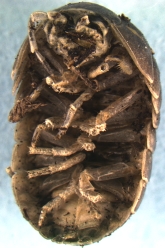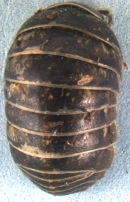Armadillidum vulgare
From ize
Taxonomy
Kingdom: Animalia
Phylum: Arthropoda
Class: Malacostraca
Order: Isopoda
Family: Armadillidiidae
Genus: Armadillidium
Species: A. vulgare
Contents |
Common name
potato bugs, pill bugs, rolly pollies.
Habitat
Armadillidium vulgare loves moisture. The most common place which they can be found is damp soil under stones or flowerpots in your garden. Spring and autumn are good seasons to find them.
External description
There are two pairs of antennae. One of the pairs is really hard to see because the first antennae are vestigial which mean no longer used. Pill bugs have two compounds eyes, one pair of maxilliped (mouth parts), and seven pairs of legs. Males have the genital projections. The lungs are located in the first pleopod.
Behavior
Pill bugs live in family groups. The male and female gather food for the family. Usually, the male protects the family. In spring, the young make their own family group within 10 to 100m of the original family’s burrow.
When pill bugs are stimulated, they immediately roll up their body and will be almost perfect global shape. This is the most common habit of Armadillidium vulgare. The habit is excellent defense from their predators such as centipedes, spiders and birds because all sensitive organs can be protected.
Diet
Armadillidium vulgare feed on fungi, fallen leaves, or dead animals.
Reproduction
Pill bugs usually mate once a year in spring. They reproduce offspring on land not in water. After the eggs are fertilized, the eggs develop in a brood pouch filled with fluid. The young stay a few days in the brood pouch after hatching. When they fully develop, they are released into the soil. About three weeks later, the young are a light tan color and about two to three mm long.
Molting
Their style of molting is biphasic molting, which means the posterior region molts before the anterior region. After pill bugs finish molting, they eat their empty shell to gain the calcium.
Life span
It is about two to three years.
References
The Encyclopedia of insects. Ed. Christopher O’Toole. New York: facts on File Publications, 1980. Page11
Links
Brown,C.1999. Armadillidum vulgare
http://animaldiversity.umich.edu/site/accounts/information/Armadillidium_vulgare.html
Richard,F. 2006. Invertebrate Anatomy Online, Armadillidum vulgare.
http://webs.lander.edu/rsfox/invertebrates/armadillidium.htm


